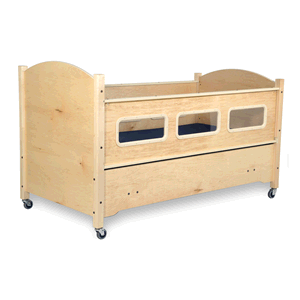An Economical Bed with Improved Transfer Height
- You are here:
- Home /
- In the News /
- An Economical Bed with Improved Transfer Height
By Robin Hocevar

SleepSafe BASIC Safety Bed offers lower transfer height and more safety rail protection.
For caregivers of patients with cerebral palsy or other medical conditions requiring a transporter to position them in a wheelchair, an adaptable bed can be an answered prayer.
Sleep issues can plague patients with cerebral palsy (CP) and their caregivers. Difficulties in falling asleep, waking because of pain, seizures, gastrointestional issues, thrashing and bedwetting are all too common for patients with cerebral palsy and other brain injuries. Babies and young children with CP are safest in a crib but are developmentally ready to transition to a bed by age 2-3. Remaining in the crib past toddlerhood perpetuates the “baby” image and children often physically outgrow it, yet it’s often unsafe even for adults with CP to sleep in a bed with standard guard rails.
Unfortunately, for a growing number of patients and families, an adaptable bed is a pipe dream. According to Gregg Weinschreider, president of Safe Sleep Beds LLC®, adaptable beds manufactured by his company and competitors cost approximately $5,995 and insurance reimbursement is becoming harder to guarantee.
With this in mind, Safe Sleep Beds LLC® created a bed to offer a more affordable option for patients and their caretakers. The SafeSleep® Basic Safety Bed was introduced at The Abilities Expo in July to fill the market’s growing need for cost-conscious medical equipment.
“This bed is coming in at a significantly lower cost,” said Weinschreider. “Everyone struggles with insurance and this will be more attractive to the insurance companies since the retail is down.”
Part of the reason the company can offer this model at such a reduced cost is due to the more limited design options.
Customers may choose between maple and oak finishes. The wood finishes may show some natural knots but both are popular options.
Other options like windows, slots for feeding tubes, IV poles and Bunkie Board foundations are eliminated with this model as well in the name of simplicity.
The bed is offered in a twin size only and is designed for adults. According to Weinschreider, the company is considering developing a full version of the basic bed in the future if there’s indication of a market need.
One of the positive elements surrounding the lack of custom options on this bed is the corresponding quick delivery time. Most of the products from Safe Sleep Beds LLC® take 1-2 weeks to arrive in home. The SafeSleep® Basic Safety Bed can be shipped in 2-3 days, said Weinschreider. For caregivers who are sacrificing their own sleep because they’re worried about their patient’s safety in a regular bed, a few extra days of nighttime shuteye can feel life-affirming.
Transfer Height Advantage
Cost notwithstanding, one of the greatest advantages of the basic bed is the transfer height of 21 ¼”. A transfer height is the distance from the top of the side panel (below the safety panel) to the floor. Weinschreider said transfer heights can range from 18-22”.
“A lot of our parents are transferring kids in and out of wheelchairs,” explained Weinschreider. “We were able to get the transfer height up so it’s as seamless of a transition as possible.”
In addition, the safety rail is a bit higher than the other models at 17”. The higher safety rail affords extra protection for sleepers who may be more active. Doctors usually recommend safety rails that extend high above the mattress for patients who can sit up, kneel, or stand or pull up to these positions in the bed.
Safety also is an important consideration for patients with respiratory issues or acid reflux, so the foundation is articulated in the basic version. The same positioning option is standard in all other Sleep Safe® beds. This foundation features head and knee elevation by remote control. As with the fixed foundation, users can select from a choice of height positions at the time of installation.
Customers have the option of ordering extra padding, but that decision must be made during the initial purchase since retrofitting the bed in the future is very costly. The padding is installed on each side of the bed and comes with special instructions to stop using the bed if the pads are removed in order to avoid entrapment.
Entrapment issues are further diminished even with the basic bed. Winschreider explained that the space often left open between the side rails and bottom of the bed or headboard is nonexistent.
Safety was the reason the company was initially founded in 2000 and remains a cornerstone of corporate philosophy. Weinschreider sees the SafeSleep® Basic Safety Bed as the latest endeavor to keep up with the healthcare landscape without sacrificing the patient’s well-being.
“There’s a lot of uncertainty in the insurance industry right now,” said Weinschreider. “We’re excited to see what the insurance companies say about this product and think it will help patients.”